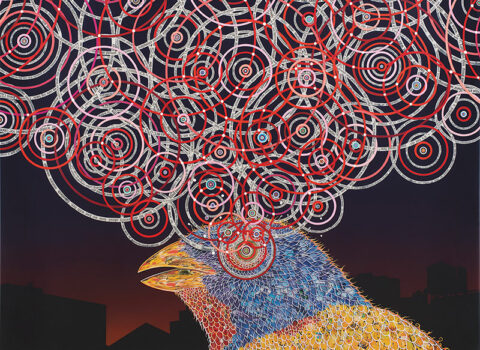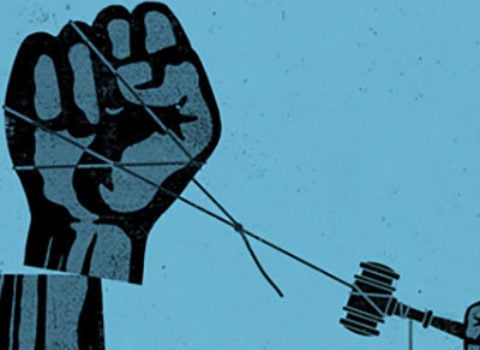Garret Keizer is a contributing editor of Harper’s Magazine. His most recent book is The Unwanted Sound of Everything. This is an excerpt from his essay “Getting Schooled,” which was published in the September 2011 issue of Harper’s. Subscribers can read the full piece here.
On the first day of school I begin my classes with John Coltrane’s “Welcome,” at the closing bars of which a palpable attentiveness comes over my chattering students, proof of what I’ve always believed about the source of Coltrane’s genius and the wellspring within even the dopiest-seeming kid. “This is nice music,” one boy remarks, and no one sneers. As I will do with the other musical introductions I play throughout the year, all chosen to fit the interval between passing bells, I key in my selection on a purse-size CD player, as quaint to the iPod generation as a Victrola is to me. I write the name of each artist and piece on the blackboard, including the date of composition when I can find it, usually a year predating that of my students’ birth (circa 1995).
I wear a jacket and tie almost every day, one of the few adults at school who do. To these I add a pair of well-oiled work boots, an offhand expression of solidarity with the parents of our community but mostly a concession to my falling arches. For the first time in many years I have what can be called a “look”—like me and like the white-collar trade of teaching itself, a strange amalgam. A girl passing in the hall remarks that I always look “spiffy.” I reply that I would have thought I looked old. “Hey, how old are you?” she counters. “Thirty?” I take this as a compliment and beam accordingly, though on reflection I wonder if she is simply trying to agree that I am old.
In this exchange and in countless other particulars, I find confirmation of the maxim that “kids are kids.” I have been warned to expect big changes between now and the old days, but for the most part the students I meet are interchangeable with types I taught more than twenty years ago, even down to the baseball caps. I’m a bit surprised by the ubiquitous display of décolletage, the respectability of the word sucks, and the number of students who readily identify themselves as “attention deficit.” If such a disorder exists, as I’m inclined to think it does, I’m glad there are medicines to treat it, although hearing someone say “I’ve got ADD” in a culture of such vast distractedness is a bit like having a fellow passenger on an ocean liner tell you that she feels afloat. Who doesn’t?
As I expected, there have been a number of changes in the school itself. A sophisticated alarm system needs to be deactivated if you’re the first person into the building and set again if you’re the last to leave, and as I am reminded on one particularly flustered Saturday morning, it’s linked to the Office of Homeland Security. In accordance with state standards, paragraphs are now called “constructed responses.” A staff meeting to discuss students in academic jeopardy is called an EST (Educational Support Team). A kid out of jeopardy is making AYP (Adequate Yearly Progress). This profession-wide penchant for jargon in general and three-letter shorthand in particular, a pidgin derived from government commissions and gypsy consultants, makes the school seem forbiddingly foreign to me at first. My skepticism shrinks somewhat after attending my first morning EST and listening to my colleagues discuss how to make a more collaborative effort on behalf of the drowning students they share. Call it what you will, it can be a PIS (Pretty Impressive Sight).
By far the most noticeable and happy improvement is the number of places to which students can turn for academic assistance. What had previously been one highly stigmatized “special ed” room is now a bustling network of study areas, all staffed by unflappable, diehard tutors, most of them proficient in several subjects. Some of these areas are devoted to students with identified special needs, but there’s a laudable blurring of the boundaries, at least on the surface, that seems to make it easy for kids to feel comfortable in any given room. The word retard sadly persists in the hallways but is used mostly as an all-purpose, gender-neutral alternative to peckerhead.
Not surprisingly, many of the more salient changes are technological. The library looks like a NASA control center in which the controllers occasionally spend their break periods with a book. The proverbial dog who ate the homework is now a flash drive. Smoking in the boys’ room is now texting in the boys’ room, though to their lasting credit the addicts of yesteryear were usually able to survive at least an hour without a drag. I frequently hear the phrase “school of the 21st century” and understand it to mean the school with more wires. During one of the first staff-training days, the district superintendent tells us that 10 percent of all high school education will be computer-based by 2014 and rise to 50 percent by 2019, the implication being how close to obsolescence our methods and we ourselves have become. No one ventures to ask what would seem to be the obvious question, which is what sort of high school education Bill Gates and Steve Jobs had and what they might have failed to accomplish without it.
Such caveats aside, I come to appreciate the advantages of a computerized grade book, though like other old-timers on the staff I keep an antique paper ledger “just in case.” The end-of-marking-period all-nighter with a roped-in spouse doing backup duty on a calculator has mercifully gone the way of the mimeograph blues. Naturally, the resulting expectation is that the emancipated teacher will gather more assessments and record them in a more “timely” fashion.
In the increased emphasis on data and the imposed emphasis on standardized jargon and tests, including the standardized inanities that result (no student I meet seems to believe that the universe formed in six days but a disturbing number insist that an essay is always formed in five paragraphs), I sense the encroachment of the totalitarian “business model” that has destroyed family farming as a way of life, of the same itch for arcane nomenclature that has turned literary criticism into a pseudoscience. A veteran foreign-language teacher still going strong since my last stint at school says to me with a sigh, “I’m afraid the day of the teacher-as-artist is drawing to a close.”
That seems to be the theme of the text we study together as a faculty. According to its authors, who shamelessly recount their exemplary and now franchised successes in a middle- to upper-middle-class high school, the day of the “lone wolf” teacher is done. We must shift from “an external focus on issues outside of the school” to a focus on what business consultant Jim Collins calls “the brutal facts” of our “organization.” The notion that the very same teachers who made the greatest difference in my life need to be purged from the ranks is dispiriting enough, but the outrageous suggestion that the “brutal facts” of education have more to do with the schoolhouse than with the larger society in which my students live is enough to make me want to spit. Or teach.
To read the rest of “Getting Schooled,” subscribe to Harper’s Magazine.









































































































